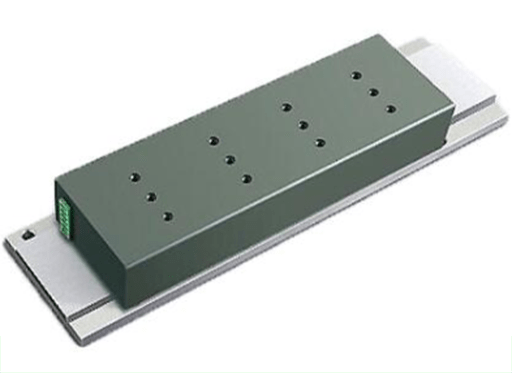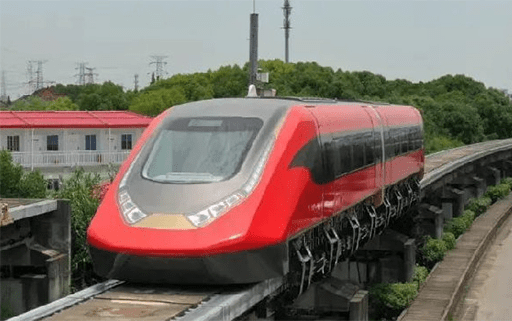
Figure 1: Iron core linear motor.
Linear motors (direct drive linear motor), like rotary motors, also have two main application areas: drive and control. Drive type linear motors are mainly used in maglev trains, wheel-rail trains, elevators, electromagnetic launchers, etc., and control type linear motors are mainly used in servo systems such as machine tools, aircraft, and automobiles. The following will introduce 5 common linear motors.
1. Linear Induction Motor
The linear induction motor is a single-sided excitation motor with a very simple structure, so it is widely used in medium and low speed rail transit systems in an early time. The common linear induction motor has a single-sided stator structure. In order to improve the magnetic circuit and improve the efficiency, a double-sided linear induction motor can also be used. Linear induction motor is characterized by unilateral excitation. Generally, the mover adopts induction plate (solid, no winding), which has a simple structure and is economical.

Figure 2: Rotary induction motor and linear induction motor.
2. Linear Synchronous Motor
The linear synchronous motor is a double-sided excitation motor, and the structure is more complicated whether it uses a long stator or a short stator. However, the linear synchronous motor in the high-speed maglev train adopts a long stator almost without exception.
This is because: synchronous motor rotor excitation power is much smaller than the stator, so the excitation winding (rotor) with less power is installed in the vehicle. The rotor excitation coils can be powered by harmonic generators and batteries or another choice is the use of superconducting coils, avoiding contact with rails and enabling high-speed operation.
Synchronous linear motors feature good power factor and high efficiency, so they are more suitable for large air gaps and high-power motors. Therefore, high-speed maglev trains mainly use linear synchronous motors. Synchronous motors have a prominent advantage when used in maglev trains: since the rotor is an electromagnet after excitation, it can be used as a maglev magnet on a maglev train, playing the roles of both a traction system and a maglev system, thereby reducing the weight of the vehicle.

Figure 3: Maglev train in red.
3. Permanent Magnet Linear Motor
Permanent magnet linear motor is also a kind of linear synchronous motor, but its rotor no longer uses electric excitation, but uses permanent magnet poles. The advantages of permanent magnet linear synchronous motor are single-sided excitation and high magnetic flux density, so it is small in size and high in efficiency.
However, since permanent magnets are not as easy to adjust the magnetic flux as electromagnet, so permanent magnet linear motors have poor field weakening control performance. Moreover, after all, the cost of permanent magnet materials is high, so it is more suitable for occasions with short orbits or closed environments, such as missiles launchers, and is less used in vehicles.
In recent years, due to its small size and high control accuracy, cylindrical linear permanent magnet motors have been used more and more in servo systems. Especially in CNC equipment and other applications requiring high precision positioning, permanent magnet AC linear synchronous motors are basically used.

Figure 4: Sectional view of cylindrical permanent magnet linear generator.
4. Doubly-fed Linear Asynchronous Motor
The synchronous motor is bilaterally excited, so the DC excitation current of the rotor can be adjusted; while the rotor current of the ordinary linear induction motor is generated by induction and cannot be adjusted artificially, which is also the reason for the poor speed regulation performance and power factor of the induction motor. A doubly-fed asynchronous motor can adjust the rotor current independently, but unlike a synchronous motor, the rotor is also an AC current. This type of linear motor is mainly used in vehicles because its speed can be adjusted by adjusting the rotor current.
5. Linear Switched Reluctance Motor
The linear switched reluctance motor is the same as the rotary switched reluctance motor, and has the advantage of single-sided excitation. Its rotor is solid steel without winding, and its cost is lower than the linear induction motor, so it is a very promising drive solution. However, in the case of a large air gap, the reluctance change of this motor magnetic circuit is small, which affects the improvement of power density, so it is less used in vehicles.Linear switched reluctance motors can be divided into two categories: longitudinal magnetic flux and transverse magnetic flux in terms of magnetic circuit structure. In recent years, linear switched reluctance motors have begun to be used in servo systems and actuation systems.
Related Info
What is Permanent Magnet Synchronous Electric MotorWhat is Synchronous Motor
What are the Advantages of Synchronous Reluctance Motor?
Types of Linear Motors
What is Linear Motor and How Does It Work?


